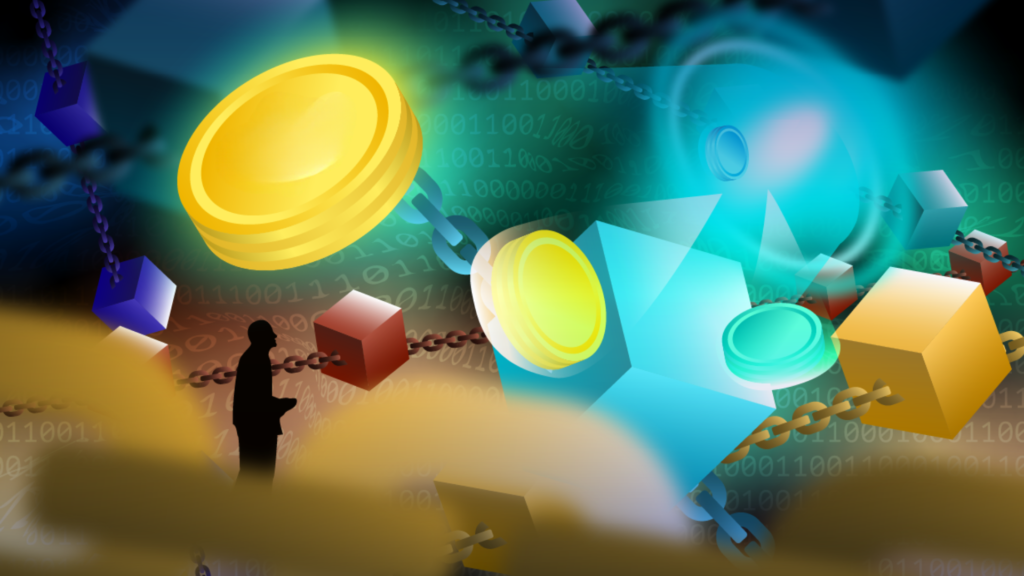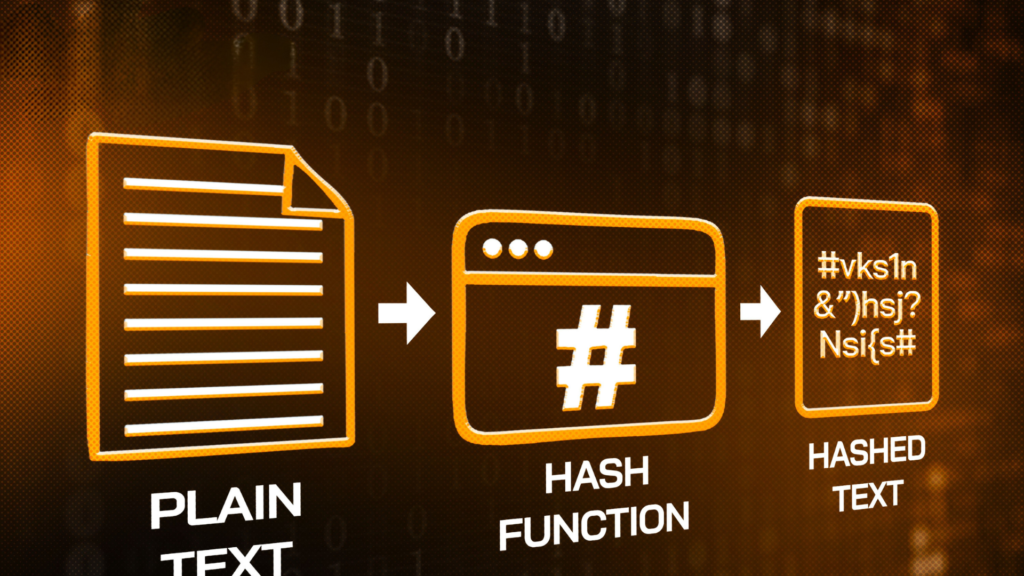Explore the role of Tokenomics and how it influences investment decisions in a project through this article by Coin98 Insights.

What is Tokenomics?
Tokenomics is a term that combines the words “Token” and “Economics.” It can be considered the “economics of cryptocurrency,” how they are designed and applied to a project’s operating model. The term Tokenomics is widely used in crypto investing.
Why is Tokenomics Important?
Before answering this question, let’s go through a little quiz!
Look at the image below and imagine the crypto market as a card game with multiple participants, including:

- Developer: Andre Cronje, Vitalik Buterin…?
- Market Maker: CZ Binance, Sam FTX…?
- Large Investment Funds: a16z, Multicoin, ParaFi…?
- Retail Investors: The majority of users (including myself).
So who are the ones sitting closest to the chessboard, who are the ones controlling the game?
Looking at the image above, users will see that even Justin Sun can’t get close to the game, so surely small investors like us are standing outside the casino, only able to hear about the results of the game.
This is indeed the reality. We are playing a game created by Market Makers, Builders/Developers, and large investment funds. From the trends of ICOs, IEOs, IDOs to NFTs and GameFi across ecosystems.
So how will they control the game?
It’s through tokens, which are what users use to buy, sell, and place their trust in. But tokens are built by experienced developers, builders, and market makers. In the short term, the crypto market is a zero-sum game, everyone wants to make money, so who will lose?
If you want to make money and understand what Market Makers are doing, users need to understand how Tokens work, or in other words, that’s TOKENOMICS.
We will continue to learn about how the big guys operate Tokenomics!
Factors that Make up a Token and Tokenomics
This is a rather long section, but it will link and provide useful insights for the following sections, so don’t miss it.
Before diving into the analysis of the application and value of tokens for the project, Coin98 Insights will analyze from basic to advanced, including:
Coin/Token Supply
Previously, Total Supply and Circulating Supply were two frequently used concepts. However, both Coingecko and CoinMarketCap have added a new concept called Max Supply – this is a concept easily confused with Total Supply.

1. Total Supply is defined as the total number of coins/tokens in circulation and locked, minus the number of coins/tokens that have been burned. Initially, the Total Supply will be a figure designed by the project development team to best suit the operating model.
More specifically, Total Supply will have the following forms:
- Fixed Total Supply is the number of coins/tokens predetermined initially and cannot be changed. For example, the total supply of Bitcoin is 21 million BTC, the total supply of Uniswap is 1 billion UNI…
- Unfixed Total Supply
- Gradually increasing total supply due to additional mining. For example, the number of ETH on the market will depend on the performance of the Ethereum network, CAKE will be minted when users farm on Pancakeswap,…
- Gradually decreasing total supply due to burning. For example, Binance Coin has an initial total supply of 200 million BNB and is gradually burned to 100 million BNB,…
- Continuously changing total supply due to the Issue-Burn mechanism. For example, mainly Stablecoins such as Algorithmic Stablecoins (FEI, AMPL…), Crypto-backed Stablecoins (DAI, VAI…), Centralized Stablecoins (USDT, USDC…).
- Circulating Supply is a concept that refers to the number of tokens currently circulating in the market.
- Max Supply will determine the maximum amount of tokens that will exist, including those that will be mined or available in the future.
- Reading Token Supply

Above are the Token Supply parameters of 3 different coins/tokens:
- ETH: Ethereum is a token with no maximum supply (No Max Supply) and will be minted further when there is a need to use the network. After being minted, ETH will be circulated and not locked by any organization (Circulating Supply = Total Supply).
- SRM: Serum is designed with a maximum amount of 10 billion SRM (Max Supply). At present, the highest number of SRM that can be reached is 161 million SRM (Total Supply), however, the actual circulating amount is only 50 million SRM (Circulating Supply).
- NEAR: Near Protocol’s Token Supply is the most basic and common type. The total supply and the number of tokens initially designed will be equal (Max Supply = Total Supply), gradually unlocked until reaching 1 billion NEAR (Circulating Supply).
Market Cap & Fully Diluted Valuation

Market Cap is the capitalization of the project with the number of tokens circulating in the market at that time. From the Circulating Supply, we can calculate the Market Cap.
Market Cap = Circulating Supply * Token Price
Fully Diluted Valuation (FDV) is the capitalization of the project but calculated with the total number of tokens in circulation and those not yet unlocked by the project. From the Total Supply, we can calculate the FDV.
FDV = Total Supply * Token Price
Why Does Market Cap Affect Growth Potential More Than Price?
Currently, the price of a token depends on many factors, in addition to Fundamental Analysis, it also depends on the initial Total Supply of the token. For example, a project with token A has a Market Cap of $10,000,000:
- If the project issues 10,000,000 A tokens ⇒ Each A token = $1.
- If the project issues 10,000,000,000 A tokens ⇒ Each A token = $0.001.
The number of tokens issued can range from tens of thousands to several billion tokens, but market capitalization is the important factor affecting the growth potential of the token.
For example: Suppose Aave and Compound are two projects with equal fundamental analysis potential in the Lending sector. Therefore, Compound can reach the Market Cap of Aave.
In terms of price, each COMP is priced higher than AAVE, but COMP has higher growth potential because Compound has not yet reached its “ceiling.” If Compound reaches the Market Cap like Aave, each COMP could reach $735

Token Governance
Currently, there are about 10,000 coins and tokens on the market. However, not all tokens follow a Decentralized mechanism like Bitcoin; there will be tokens/coins governed by a Centralized mechanism. I will divide them into 3 basic types:

Decentralized (Decentralized Token) refers to coins/tokens with a governance mechanism entirely determined by the community and not subject to governance pressure from any organization. Examples include Bitcoin, Ethereum, and so on.
Centralized (Centralized Token) refers to coins/tokens with a governance mechanism determined by a leading organization, which has the power to influence the nature of the coin or the project that the token represents. These are often fully-backed stablecoin projects like Tether, TrueUSD; exchange tokens like Binance, Huobi; or projects with a centralized governance model like Ripple.
From Centralized to Decentralized: There are also coins/tokens built with an initially centralized governance mechanism that is gradually decentralized to the community.
For example, Binance Coin was initially entirely governed by Binance. However, after some time with the launch of Binance Smart Chain and the “Validator Spotlight” program, Binance has gradually decentralized the BSC network and BNB token for user control.
Token Allocation
Before investing in a token, Token Allocation helps users understand whether the token allocation ratio among Stakeholder groups is reasonable, as well as their impact on the overall project.
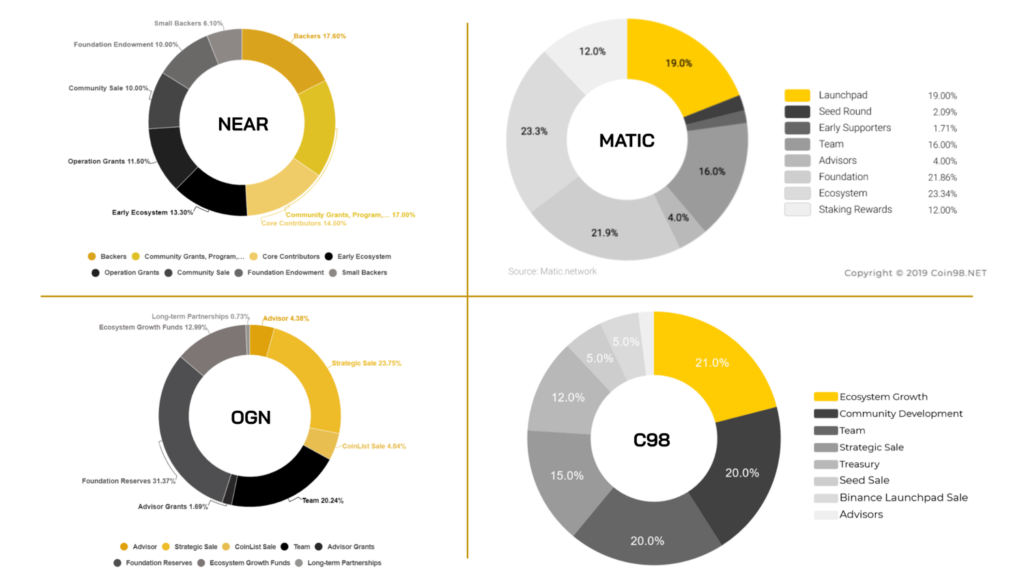
1. Team
This is the portion of tokens allocated to the project development team. This includes the amount of tokens held by members who contribute value to the project, such as founders, developers, marketers, and advisors. The ideal number is usually around 20% of the total supply.
- If this ratio is too low, the project team will not have the motivation to develop the project in the long term.
- If this ratio is too high, the community will not have the motivation to hold the project’s tokens, as the tokens are being dominated too much by one entity. This causes some problems such as concentration of power and high potential for price manipulation.
- Foundation Reserve
The Reserve is the project’s reserve to develop products or features for the future. This is a token allocation with no specific quantity regulation, usually accounting for 20-40% of the total supply.
- Liquidity Mining
Liquidity Mining is an allocation that has appeared a lot recently, especially after DeFi projects have grown strongly since September 2020.
Liquidity Mining is the amount of tokens minted as a reward for users who provide liquidity to DeFi protocols.
- Seed / Private / Public Sale
This is the number of tokens reserved for fundraising sales rounds to develop the product. Usually, the project will have three rounds of sale: Seed sale, Private sale, and Public sale (details in the Token Sale section).
- Airdrop / Retroactive
To attract initial users, projects often airdrop a very small portion of the project’s token allocation to users. This usually accounts for about 1-2% of the total supply.
Around 2019 and earlier, to receive an Airdrop, users only needed to perform a few simple actions such as Like, Follow, and Retweet posts on their Twitter page.
However, since 2020, the conditions to receive Airdrops have become much more difficult, requiring users to “skin in the game,” meaning they need to use the product to be eligible for Airdrops or Retroactive rewards. Some typical Retroactive examples include Uniswap (UNI), 1Inch Network (1INCH), and so on.
Learn more: What is an Airdrop? How to Participate in Airdrops Effectively
- Other Allocation
Depending on each project, they will have a portion of Allocation dedicated to a specific case, which could be Marketing, Strategic Partnership, etc.
Usually, this allocation has a small proportion and can be included in the Foundation Reserve.
Differences Across Two Cycles:
- 2017-2018: Public Sale accounted for more than 50%, Insiders accounted for less. Examples: ADA, ETH, XTZ, ATOM…
- 2019 onwards: Public Sale accounts for 20-30%, Insiders account for the largest proportion. Examples: NEAR, AVAX, SOL…
Where:
- Public Sale is the amount of tokens sold to the community.
- Insiders include the development team, investment funds,…
This can be explained because previously, project tokens were not widely used in the ecosystem, and they needed capital to be able to develop the project.
At present, the market has seen the emergence of large investment funds, and tokens are widely used within the platform. Therefore, Insiders and the Foundation will account for a large amount of tokens on the market.

Token Release
Token Release is a project’s plan to distribute tokens into the circulating market. Similar to Token Allocation, Token Release greatly influences the token’s price and the community’s motivation to hold the token. Currently, there are two types of token distribution in the market:
- Distributing tokens according to a predetermined schedule
Each project will have a different token release schedule, but I can categorize them into the following time frames:
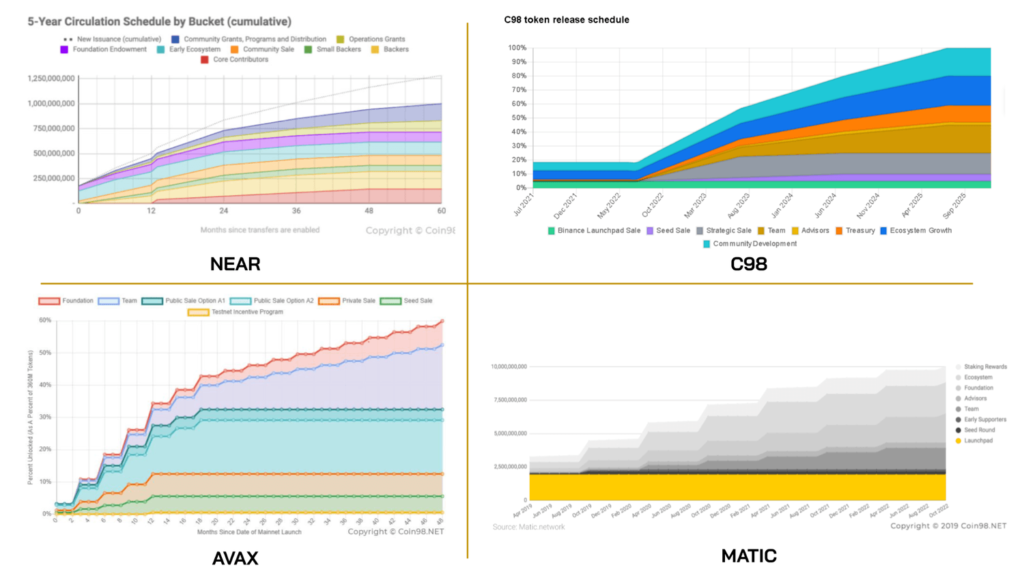
Under 1 year: Projects that release 100% of tokens in less than a year show that the project team is not committed to their product in the long term and cannot create much value for the platform or the token.
From 3-5 years: This is the most ideal time frame to release 100% of tokens because the crypto market changes very quickly. Since becoming “mainstream” in 2017, the crypto market has only gone through about 5 years.
Each year, the market has witnessed the elimination of many ineffective projects and the launch of many more potential projects. Therefore, 3-5 years is the most ideal number to promote the development motivation of the team, as well as the motivation to hold tokens from the community.
Over 10 years: Except for Bitcoin, projects with a token release schedule of up to 10 years will find it difficult to motivate holders because they suffer from token inflation for up to 10 years, and no one guarantees that the team will operate effectively during that time.
Thus, the number of tokens released must be designed to balance the following two factors:
- The benefits of token holders when holding the platform’s tokens.
- The value of the number of tokens released each day (inflation).
If the number of tokens released is too fast compared to the project’s operating performance, the token price will tend to decrease because users have no motivation to hold the token.
- Allocating tokens based on performance and usage demand
To solve the problem of inflation occurring too quickly compared to the original plan, some projects have chosen to release tokens according to specific criteria rather than a predetermined time. This is a pretty good mechanism because it will help stabilize the price of the token more if applied reasonably.
For example, MakerDAO also does not have a specific token allocation time. Depending on the actual usage demand on the platform, the number of MKR will be allocated reasonably ⇒ MKR tokens will only be released when there is Lending or Borrowing activity.
Token Sale
Token sale can be considered a form of fundraising by selling shares, similar to companies in the traditional market. However, in the crypto market, shares will be replaced by tokens.
While traditional companies have about 5 rounds of fundraising, Crypto projects will have about 3 rounds of token sales to raise capital. Usually, the valuation of a company will not be specific to each industry, region, and scale. However, in Series C, strong companies can completely value themselves from 100 million USD or more.
- Traditional Company: Pre-seed, Seed, Series A, Series B, Series C.
- Crypto Project: Seed Sale, Private Sale, Public Sale.
For the crypto market, the average valuation will be lower because this is a relatively new market and has a much smaller market cap than the stock market of some large countries
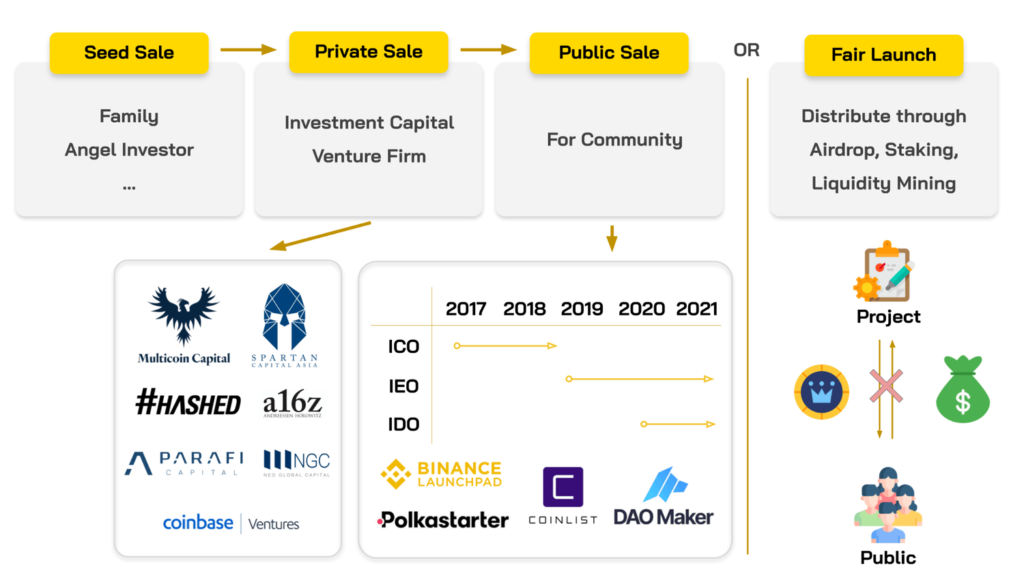
1. Seed Sale
The Seed sale is the project’s first token sale. In this round, most projects have not yet completed their product. Some projects conduct token sales as a form of fundraising for development.
The funds invested in the Seed sale are mostly venture capital funds; they accept high risks but will also receive worthy rewards if the project is successful.
- Private Sale
While the Seed sale mainly involves venture capital funds, the Private sale will have the participation of larger and more reputable investment funds. Usually, at this stage, the projects have launched their products and proven some of their achievements after raising capital in the Seed sale round.
- Public Sale
The Public sale is the round of selling tokens to the community. The project can launch tokens in the form of an ICO like in 2017, or launch tokens with the help of third parties in the form of an IEO or IDO.
- Fair Token Distribution
However, many projects do not sell through any form but will be distributed through activities such as Testnet, Airdrop, Staking, Liquidity Providing, etc. This helps the project become more “equal” to the interested community and reach more users.
Some notable Fairlaunch projects include Uniswap (UNI), Sushiswap (SUSHI), Yearn Finance (YFI), etc. They do not sell tokens under any form to raise funds beforehand but will distribute tokens to actual users of the platform.
Some advantages and disadvantages of this mechanism:
- Advantages: Tokens are distributed to those who contribute value to the project, reducing the situation of deep “dumps” caused by people who bought in the Seed sale and Private sale “dumping” tokens.
- Disadvantages: The project “misses” a portion of the capital that can be raised from the community to develop the project.
- Impact of Token Sale on Tokenomics
There is no specific regulation or standard for the price difference between token sale rounds. For a project, the Public sale price can be double the Private sale price, and the Private sale price can be double the Seed sale price. This depends entirely on the project.
However, they will maintain a reasonable difference. Because if the selling price of each round has a very high difference, early investors will tend to take profits early, and conversely, later investors will not have the motivation to participate in the sale.
Therefore, the projects will apply an additional token release mechanism to reasonably allocate benefits among investors. If the price difference of each round is high, early investors must endure a longer lock-up period. Conversely, investors who buy at a higher price will have their tokens unlocked sooner.
Token Use Case
Token Use Case is the purpose of using a token; this is the most important factor of tokenomics, helping users to value a token in the market, based on the benefits that the token brings to the holder.

Typically, tokens will have the following functions:
- Staking
Currently, most projects support Staking for their native tokens. This motivates users to hold tokens because they are distributed more tokens as interest. Without a Staking mechanism, token holders will suffer from inflation because a new amount of tokens is minted into circulation every day.
In addition, Staking also has the added benefit of helping to reduce the number of tokens circulating in the market, which reduces selling pressure, making it easier for the price to grow. For networks using the Proof-of-Stake mechanism, the increasing number of staked tokens also helps the network become more decentralized and secure.
For example, Cardano (ADA) has grown from $0.2 to $2 (1,000% growth) since the beginning of 2021. In theory, to grow like that, the amount of capital poured into Cardano must increase 10 times.
However, in reality, it is not like that; the amount of capital poured into Cardano is much lower. What makes Cardano grow so strongly is because 75% of Cardano in circulation has been staked, which helps reduce the selling pressure of ADA in the market, creating momentum for ADA to grow.
- Liquidity Mining (Farming)
For DeFi tokens that have appeared a lot recently, users can use them to provide liquidity to DeFi protocols; in return, they will be rewarded with the project’s native tokens.
For example, provide liquidity to Uniswap to receive UNI…
- Network Fees (Transaction Fees)
To make a transaction, users need to pay a fee to the network, more specifically to the Validators so that they can confirm the transaction. Each blockchain network will have its own native token used to pay network fees (usually projects operating in the blockchain platform sector).
For example:
- Ethereum uses ETH.
- Binance Smart Chain uses BNB.
- Solana uses SOL.
- Polygon uses MATIC.
- Governance
I mentioned this part above; platforms can be governed by a Centralized or Decentralized mechanism depending on the project developer. However, most current DeFi platforms are governed by a Decentralized mechanism.
This means that token holders will be able to propose and vote to make changes to the platform they participate in. Proposals may relate to transaction fees, token release speed, or larger issues such as proposing to the project development team to expand to a new blockchain.
Currently, prominent DeFi platforms such as Uniswap, Sushiswap, Compound… have all applied the Decentralized Governance mechanism, allowing users to participate in governance.
However, most of the community only stops at the Voting power and cannot create Proposals for the platform because the number of tokens required to create a
- Other Benefits (Launchpad…)
This is one of the important factors that helps tokens circulate and creates great motivation for users to hold tokens. Launchpad projects usually require users to stake tokens to be able to participate in sales rounds or be eligible to participate in NFT lottery programs, etc.
For example, Polkastarter requires holding POLS, DAO Maker requires holding DAOS…
Case Study on Tokenomics
Disclaimer: This is a personal perspective and should not be considered investment advice in any form.
Note: To evaluate whether a project has growth potential, Tokenomics is an important factor. However, the price of the token as well as the potential of the project are also evaluated through many other factors. Tokenomics is not the only factor affecting the growth potential of the price.
Below, I will mention some projects with effective and ineffective tokenomics so that users can easily visualize.
Effective Tokenomics
- Binance Coin (BNB)
Token Supply
- Initial total supply: 200,000,000 BNB.
- Unlock time: 5 years (100% unlocked).
- Along with the burning mechanism until the Circulating Supply is 100,000,000 BNB.
⇒ Helps reduce inflation, create upward price momentum, and create holding motivation for BNB holders.
Token Use Case
However, this is not the main reason why BNB has grown tremendously in recent times. The brightest point for BNB is the design of token use cases that allow BNB to be thoroughly applied on the Binance exchange and the Binance Smart Chain network.
- Binance Exchange: Reduced transaction fees, Launchpad participation, Staking, Collateral & Loan, Derivatives trading,…
- Binance Smart Chain: Network fees, Main currency unit, Staking, Farming (BNB is used as the main asset to create liquidity pairs, similar to ETH in the Ethereum system, and this is the main factor driving the strong growth of BNB’s buy demand).
Currently, Binance is planning to develop Binance Pay, and BNB can completely become a popular payment unit at any time if successfully applied by Binance. The success of BNB has been demonstrated through the outstanding growth chart this year.
Result: BNB grew from an accumulation price range of $20 to a peak of about $650 (+3,250%) and is maintaining at $300 (+1,500%).

2. PancakeSwap (CAKE)
CAKE is the native token of the AMM DEX PancakeSwap platform on the Binance Smart Chain ecosystem.
Token Supply
- CAKE has no total supply (no limit on the number of CAKE).
- 530,000 CAKE are distributed daily through Syrup Pool, Farming Pool, and Lottery Pool.
- CAKE will be burned when users use ANY PancakeSwap product.
Token Use Case
CAKE is designed for comprehensive use in PancakeSwap products, including Syrup Pool (Staking), Staking to participate in IFOs, and as a means of payment in Lottery and Prediction.
⇒ Although there is no total supply, PancakeSwap controls the circulating supply of CAKE very well, helping to maintain a balance between Token Release and Token Burn.
PancakeSwap has been very clever in increasing the application of CAKE tokens on the platform to create buy demand for CAKE, as well as maintain incentives for CAKE holders. Therefore, CAKE has experienced very strong growth since its launch.
Result: CAKE grew from $0.4 to a peak of $40 (+10,000%) and is holding steady at $14 (+3,500%).
Learn more: Analysis of PancakeSwap’s operating model

Ineffective Tokenomics
Pangolin (PNG)
PNG is the token used in the Pangolin AMM DEX of the Avalanche network. Although it has similar functions to CAKE in AMM DEXs, such as providing liquidity to the exchange, etc., in my personal opinion, Pangolin’s tokenomics has many problems and does not operate effectively.
Unreasonable Token Supply
The first thing is that PNG has a total supply of 538,000,000 PNG, and every 4 years the amount of PNG distributed to the market will be halved. This is a similar mechanism to Bitcoin, which makes the total time for PNG to be unlocked up to 36 years.
However, Bitcoin is an asset that has been trusted by the community, while PNG is a very new token; nothing can guarantee that the Pangolin team will continue to operate to develop the product during that 36-year period, not to mention the lifespan of the crypto market has only been just over 10 years.
Unable to Balance Revenue and Token Release Value
Secondly, at present, Pangolin is unlocking 175,000 PNG/day (worth $197,500/day). But Pangolin’s revenue is less than $30,000/day. This makes PNG holders no longer motivated to hold the project’s tokens because they do not receive worthy benefits.
Therefore, when investing in a token, users need to have a multi-dimensional perspective. The project side can “draw” many scenarios when achieving achievements, but it needs to be verified with actual data. Will the project’s revenue meet expectations?
⇒ Unreasonable Token Release Schedule, unable to apply PNG in the Pangolin platform. The “vision” of tokenomics does not match the actual data.
Result: After peaking at $15, PNG has plummeted to the current price of about $1.2/PNG (divided by 12 times). Even when the market grew strongly around April-May 2021, the price of PNG grew very weakly.
This September, the tokens of the Avalanche system also grew very strongly, such as AVAX, SNOB, XAVA… but PNG still had very slow growth. Despite being an AMM backed by Avax Labs, Pangolin has also fallen behind Trader Joe.
Learn more: Analysis of Pangolin’s operating model

Perspective on the Case Studies
As I analyzed above, the design of tokenomics is not bound by any single factor. Depending on the operating model and the target market of the project, the team will design the tokenomics in a reasonable way.
When evaluating tokenomics, users must not only assess their applications but also analyze the target market of the project.
Is the market that the project is targeting large? Does it have many users? Does the tokenomics design balance the utility for the project and the benefits for token holders?

For example, PancakeSwap (CAKE), from the beginning, they identified their target market as the Binance Smart Chain ecosystem – the ecosystem with the second largest DeFi TVL in the market and already has a large user base.
Therefore, they designed Tokenomics to dedicate a large portion to Liquidity Mining Rewards to attract a large number of users right from the start. Then, to increase buy demand for CAKE, the PancakeSwap team increased the utility of CAKE in all PancakeSwap features.
Summary
In the article above, I have provided a detailed analysis to help readers understand the structure and role of tokenomics in the market. Here are some important takeaways:
- Tokenomics is a collection of many internal factors such as Token Supply, Token Application, Token Sale, Token Release…
- Tokenomics is an important factor but cannot be separated from the operating model to accurately assess the effectiveness and growth of the token.
- Tokenomics can be “modified” with many different design approaches. But you should focus on the platform’s revenue and how the project captures value for the token (you can refer to the articles Analyzing operating models).
Disclaimer: This article is written for informational purposes and provides the personal perspective of the author and should not be considered investment advice.
Read more: If you need a product to assist with tax issues and portfolio management in crypto, check out CoinLedger
